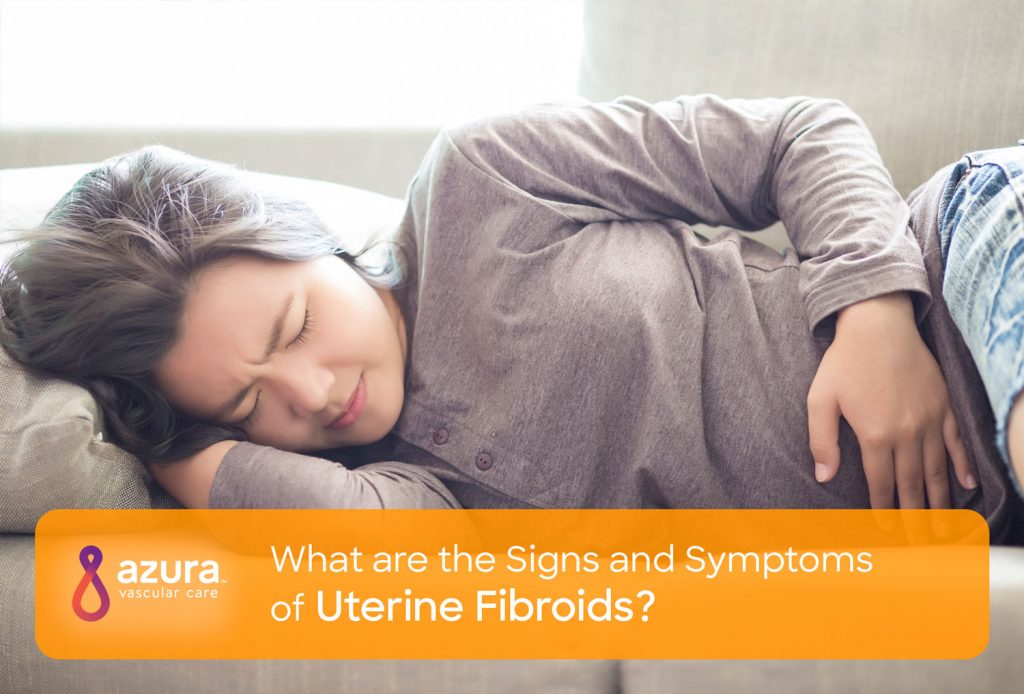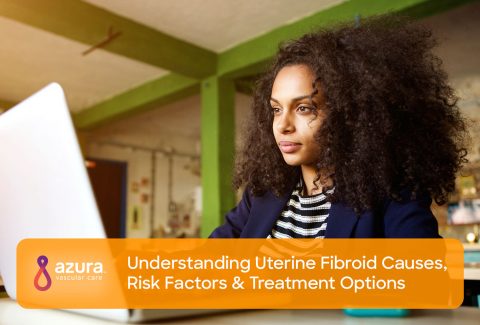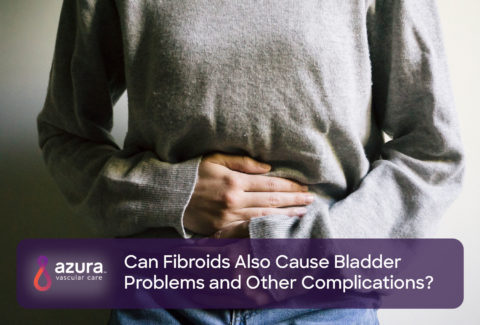
Do you have abnormal vaginal bleeding or pelvic pain? You might be suffering from uterine fibroids, non-cancerous tumors of the uterus. The symptoms of uterine fibroids depend greatly upon the location and size of the fibroids. If you’ve been experiencing pelvic pain and discomfort, and are wondering what are the symptoms of uterine fibroids, read on.
The Basics of Uterine Fibroids
So, what are uterine fibroids?
Uterine fibroids are also known as myoma or leiomyoma. They are most common in women who are in their 40s and early 50s.[i] Fibroids can be a small, single tumor, or there can be clusters of tumors. They range in size from as small as a pea or, in rare cases, to larger than a grapefruit. Many women experience no symptoms at all, but a recent internet survey showed women with uterine fibroids are more likely to have their performance at work, their sexual life, and their relationships impacted by uterine fibroid symptoms than women without them.[ii]

If you have any of the signs and symptoms of uterine fibroids listed below, you should make an appointment to see your doctor, as uterine fibroid treatment options are available. These options may include medications that lessen the symptoms, major surgery such as hysterectomy, which involves removal of the uterus and possibly the ovaries, and minimally invasive procedures such as uterine fibroid embolization.
Symptoms of Uterine Fibroids
Symptoms of uterine fibroids vary. Some women have no symptoms at all, while others experience abnormal vaginal bleeding, pelvic pain, and pregnancy issues.
Abnormal Bleeding
Heavy and prolonged bleeding is the most common presenting complaint of women with uterine fibroids.[iii] The pattern of bleeding can vary.
Heavy Menstrual Bleeding – Sixty percent of women with uterine fibroids report heavy menstrual bleeding.ii This bleeding can result in such significant blood loss that women need to take iron supplements or, in some cases, even have a blood transfusion. This heavy bleeding can consist of:
- Long menstrual periods of more than 5 days for over half of women with fibroids.[ii]
- Bleeding for more than 2 hours, with blood soaking through a pad or tampon within 1 to 2 hours.[iii]
More Frequent Bleeding – Women also note problems with bleeding between periods and some even have full periods that occur more often than would occur in a typical cycle.[ii]
Pelvic Complaints
 Because fibroids can actually take up space inside the pelvis, there are symptoms that may result from compression of nearby organs.
Because fibroids can actually take up space inside the pelvis, there are symptoms that may result from compression of nearby organs.
Problems with Urination – The bladder rests on top of the uterus. A fibroid can push up against the bladder, causing problems with emptying it. This can lead to:
- Greater urinary frequency
- Urinary incontinence
- Difficulty with urination
- Blockage of the urine flow that can damage the kidneys, known as hydronephrosis
Problems with Bowel Movements – The rectum, the portion of the large intestine that contains stool prior to having a bowel movement, sits behind the uterus. A fibroid can cause compression of the rectum and lead to problems with having a bowel movement, such as:
- Constipation
- Tenesmus, a condition in which you feel that you need to have a bowel movement, but are unable to.
Pelvic Mass – Some women may actually be able to feel a large lump or see swelling in their lower abdomen. This can happen with large uterine fibroids.
Pelvic Pain – Pain from fibroids can come from stretching of the uterus or compression of surrounding organs. About 30% of women with uterine fibroids have reported feeling pressure on the bladder or pressure inside of the abdomen. Chronic pelvic pain is more likely to be noted by women with uterine fibroids than by women without them. Pain can occur at any time during the menstrual cycle. Women with uterine fibroids are also more likely to report pain during sexual intercourse.[ii]
Pregnancy Issues
 For those with uterine fibroids, getting pregnant, maintaining a pregnancy, and delivering a baby can be more challenging.
For those with uterine fibroids, getting pregnant, maintaining a pregnancy, and delivering a baby can be more challenging.
Infertility – Up to 10% of women who are unable to get pregnant after actively trying for 12 months have uterine fibroids. Fibroids may be the only problem found in the fertility work up for approximately 2% of women. The location of the fibroid matters; if it is located closer to the lining of the uterus then it is more likely to impact fertility. In some cases, removal of fibroids might improve fertility.[v]
Uterine Fibroid Growth and Shrinkage – Up to 15% of fibroids may grow during pregnancy, but 62% of those less than about 2 inches may actually shrink.[v]
Pelvic Pain – While fibroid growth during pregnancy may not be a problem, pain related to uterine fibroids can be an issue, and up to 15% of pregnant women are admitted to the hospital for pain management. Large uterine fibroids can undergo red degeneration, when the blood supply to a fibroid is cut off by twisting around a stalk and the fibroid dies.[vi]
Problems with Delivery – Complications during delivery occur in 10% to 40% of pregnant women with uterine fibroids. These complications can consist of going into labor early, bleeding around the placenta or the sac that contains the unborn baby, problems with the baby’s position, and heavy bleeding after delivery. There is also an increased risk of having a cesarean section, where surgery is necessary to give birth to the baby.[v]
Do you feel that you have some of these signs and symptoms of uterine fibroids? If you have concerns, it is best to speak with your doctor to get more information.
Sources:
[i] http://www.womenshealth.gov/publications/our-publications/fact-sheet/uterine-fibroids.html
[ii] Zimmermann, A., et al., Prevalence, symptoms and management of uterine fibroids: an international internet-based survery of 21,746 women. BMC Womens Health, 2012. 12(6): p. 1-11.
[iii] Khan, A.T., M. Shehmar, and J.K. Gupta, Uterine fibroids: current perspectives. Int J Womens Health, 2014. 6: p. 95-114.
[iv] Mayo http://www.mayoclinic.org/symptoms/vaginal-bleeding/basics/definition/sym-20050756
[v] Cook, H., et al., The impact of uterine leiomyomas on reproductive outcomes. Minerva Ginecol, 2010. 62(3): p. 225-236.
[vi] Currie, A., et al., Laparoscopic approach to fibroid torsion presenting as an acute abdomen in pregnancy. JSLS, 2013. 17(4): p. 665-7


